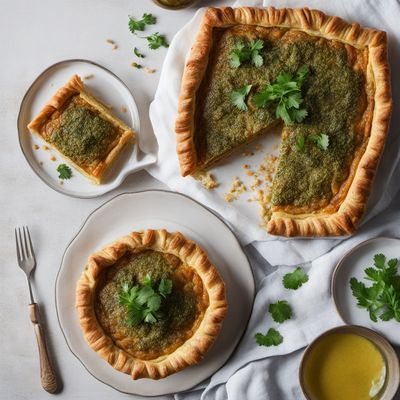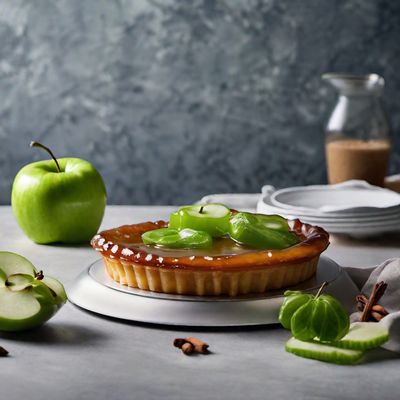
Ingredient
Croissant from puff pastry
Flaky Delights: Unveiling the Magic of Homemade Croissants
Croissants made from puff pastry are a labor of love, requiring patience and skill to achieve the perfect balance of crispiness and softness. The dough is made by layering butter between thin sheets of dough, which is then rolled and folded multiple times to create the characteristic flaky layers. When baked, the butter melts and creates pockets of air, resulting in a light and airy texture. The golden-brown exterior adds a delightful crunch, while the interior remains tender and buttery. Croissants can be enjoyed plain or filled with various sweet or savory fillings, making them a versatile treat for any time of the day.
Origins and history
The origins of croissants can be traced back to Vienna, Austria, where a similar pastry called "kipferl" was popular in the 13th century. The kipferl eventually made its way to France, where it underwent significant changes and became the croissant we know today. The French perfected the technique of laminating dough with butter, creating the flaky layers that are characteristic of croissants. Over time, croissants became an integral part of French culture and cuisine, symbolizing elegance and sophistication. Today, they are enjoyed worldwide and have become a staple in bakeries and cafes around the globe.
Nutritional information
Croissants made from puff pastry are a calorie-dense treat, with an average croissant containing around 200-250 calories. They are a significant source of carbohydrates and fats, providing energy and indulgence in every bite.
Allergens
Croissants made from puff pastry typically contain wheat, milk, and butter, making them unsuitable for individuals with gluten or dairy allergies.
How to select
When selecting croissants from a store or bakery, look for ones that have a golden-brown color and a crisp exterior. The croissants should feel light and airy when picked up, indicating that they have been properly baked. Avoid croissants that appear overly greasy or have a dense texture, as these may indicate poor quality or underbaking.
Storage recommendations
To maintain the freshness and quality of croissants, store them in an airtight container or wrap them tightly in plastic wrap. They can be kept at room temperature for up to 2 days, but for longer storage, it is best to freeze them. To freeze, wrap each croissant individually in plastic wrap and place them in a freezer bag. They can be stored in the freezer for up to 2 months. When ready to enjoy, thaw the croissants at room temperature or reheat them in a preheated oven for a few minutes to restore their crispiness.
How to produce
Producing croissants from puff pastry at home requires a bit of time and effort, but the results are well worth it. To make the dough, layer butter between thin sheets of dough and roll it out. Fold the dough multiple times to create layers, then chill it before shaping and baking. There are numerous detailed recipes and tutorials available online that provide step-by-step instructions for making homemade croissants.
Preparation tips
Before baking croissants, it is essential to let them proof at room temperature for about 1-2 hours to allow the yeast to work its magic and create a light and airy texture. For a glossy finish, brush the croissants with an egg wash before baking. To enhance the flavor, consider adding fillings such as chocolate, almond paste, or ham and cheese. Croissants can be enjoyed on their own, served with butter and jam, or used as a base for sandwiches or breakfast dishes like eggs Benedict.
Culinary uses
Croissants made from puff pastry are a versatile ingredient that can be enjoyed in various ways. They are commonly eaten as a breakfast pastry, served alongside coffee or tea. Croissants can also be used as a base for sandwiches, filled with ingredients like ham, cheese, or smoked salmon. In desserts, they can be transformed into bread pudding, used as a base for fruit tarts, or turned into decadent French toast.
Availability
Croissants made from puff pastry are commonly available in bakeries, cafes, and supermarkets worldwide. They are particularly associated with French cuisine but can be found in many countries where French pastries are appreciated.
More ingredients from this category
Recipes using Croissant from puff pastry » Browse all

Sichuan Tarte Tatin
Spicy Sichuan Tarte Tatin: A Fiery Twist on a Classic French Dessert

Caspian Eggplant Pie
Savory Delight: Caspian Eggplant Pie

Bouchée à la Reine with Mushroom and Chicken Filling
Savory Delight: Mushroom and Chicken Bouchée à la Reine

Mughlai-inspired Spiced Pastizz
Royal Mughlai Pastizz: A Fusion of Flavors

South African Chicken Pie
Savory Delight: South African Chicken Pie

Togolese Almond Pastry Roll
Savory Almond Delight: Togolese Twist on Moroccan M'hanncha

Malian-style Spiced Sausage Rolls
Savory Delights: Malian-inspired Spiced Sausage Rolls

Moroccan-inspired Roccoco with Spiced Lamb
Savory Lamb-stuffed Roccoco: A Moroccan Twist on an Italian Classic

New Mexican Tarte Tatin
Green Chile Apple Tarte Tatin

Austrian Cream Slice
Heavenly Layers of Austrian Delight

Kenyan-style Pâté en Croûte
Savory Kenyan Delight: Pâté en Croûte with a Local Twist

Vegan Wellington
Plant-Based Twist: Vegan Wellington Delight
